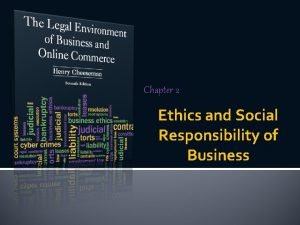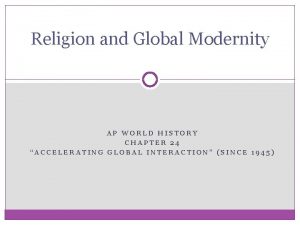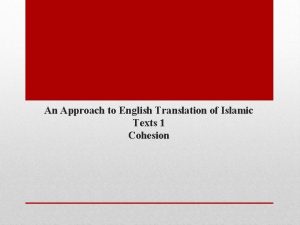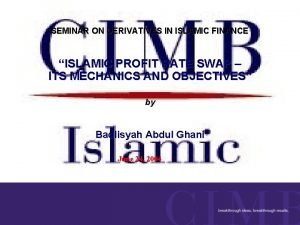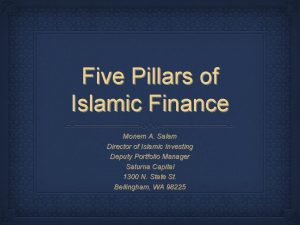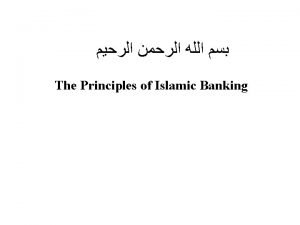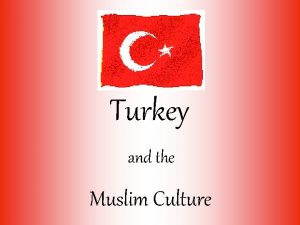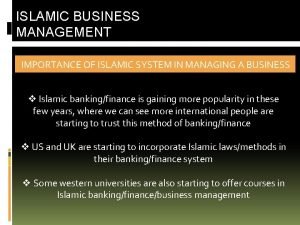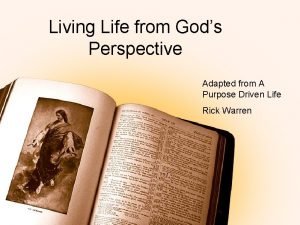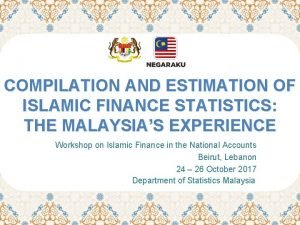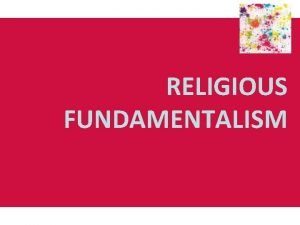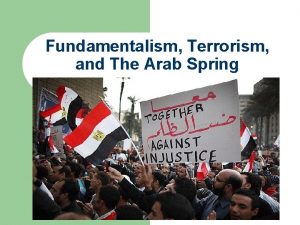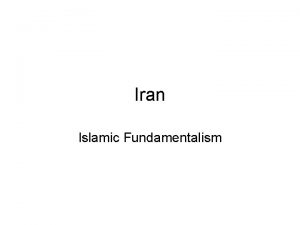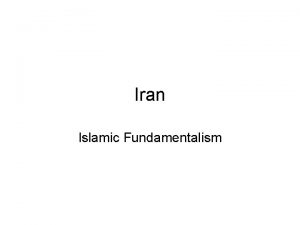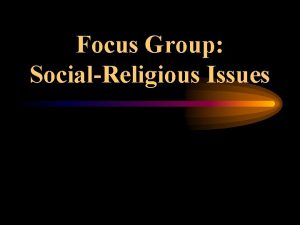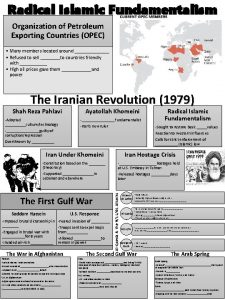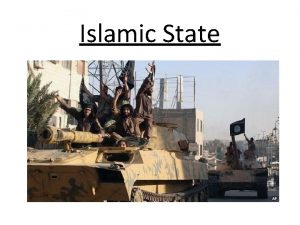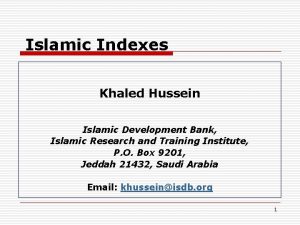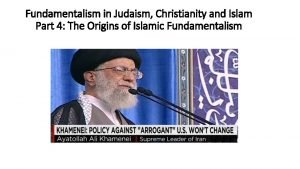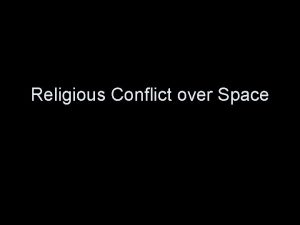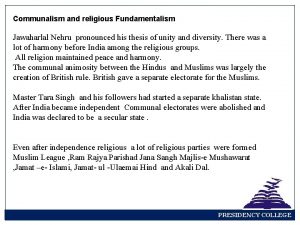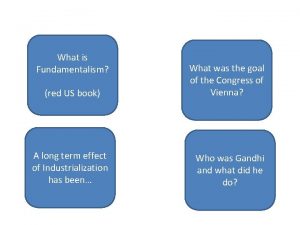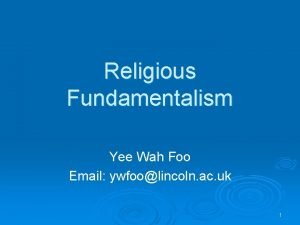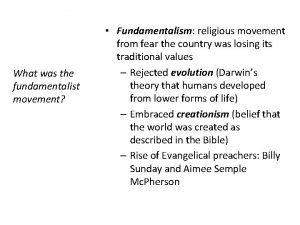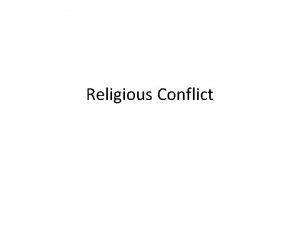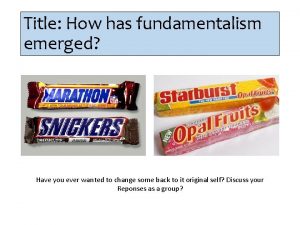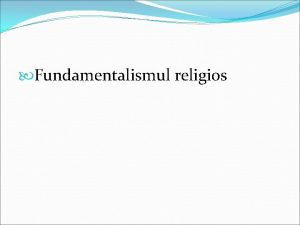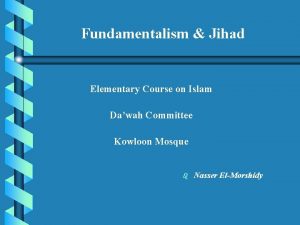Islamic Fundamentalism Islamic Fundamentalism Fundamentalism literalist approach to
















![Holy Texts: An Instrumentalist View • '[As a Jew] if you are in favour Holy Texts: An Instrumentalist View • '[As a Jew] if you are in favour](https://slidetodoc.com/presentation_image/3bc4febe58206c20f7dfc4a37f305743/image-17.jpg)











- Slides: 28

Islamic Fundamentalism

Islamic Fundamentalism • Fundamentalism: literalist approach to texts, but selecting the most world-denying, antimodern elements • Is it modern or traditional? • Is it driven by economic, political, cultural or demographic factors • Is it political or cultural?

The Rise of Islamism • Surge of Mosque-building post 1970 s • Rising support for Islamist parties • Popularity of traditional symbols of Islam (i. e. headscarf, shari’a) • Children more religious, more conservative than elders • Da’wa – ‘Call’ to Islam from early 70 s

One Example: Mosque Growth • ‘In Indonesia, mosque growth outpaced rapid population growth, raising the ratio of mosques to people by 30 percent between 1986 and 1996. In Egypt, the number of mosques outside formal government control - run by the Muslim Brotherhood and financed by the Saudis and local contributions - rose from 20, 000 in 1970 to 46, 000 in 1981. By 1991, an estimated 140, 000 were operating. ’- Kaufmann 2010

Religious Supply? • • Saudi oil money Saudi Wahhabism 30 million qur’ans per year Funding channelled through Muslim Brotherhood, Tablighi Jama’at and others • Entrepreneurial imams make tours of kingdom to solicit funds for private mosques • Private versus government mosques

Religious Demand 1. Socioeconomic (welfare state, poverty, unemployment, mass urbanisation) 2. Political (end of Cold War, authoritarian regimes, US war on terror, Israel) 3. Cultural (Islamic ‘reformation’, demise of Arab/Persian nationalism and socialism, availability of premodern exemplars and texts, anomie) • Note that 1 and 2 approximate ‘modernist’ and 3 the ‘ethnosymbolist’ position

Holy Texts: A Perennialist View • Islam: "Whoever changes his religion, kill him"- hadith • Not unique to Islam: "ye shall destroy their altars, break their images, and cut down their groves" – Exodus 34: 13 -17 • **Commentary pertaining to jihad and martyrdom • 'Anyone who can read passages like those quoted above and still not see a link between Muslim faith and Muslim violence should probably consult a neurologist' - Sam Harris, The End of Faith, p. 23 • Connection between support for religion in politics and support for violence

Holy Texts: An Ethnosymbolist View • Interpretive theologies can acquire rootedness over time • Political interpretation of jihad persisted due to anti-colonialism • Political interpretation of crusade fell into abeyance after Wars of Religion (Toft 2007) • But crusade and jihad are resources that can be unearthed in the future • Holy texts are symbolic resources

Fundamentalism: An Ethnosymbolist Explanation • Instances of Fundamentalist Revival in the Past • Modernity enhances, but does not generate fundamentalism anew • Premodern past provides symbolic resources for fundamentalists

Prophet v. Pharaoh: Premodern Fundamentalism? • Corruption of clergy • State as usurping functions reserved for religion • Foreign domination (Mongol, Crusader, Persian? , Ottoman? ) • Idolatry: state and its religious officials, schools and structures • Empire vs umma of true believers • Masses should rise up and eject the foreign infidels and their idolatrous traitor governments

Premodern Defenders of Orthodoxy • Kharijites – (from 650 s) - small sect that believed that rule should be by the book and not the law. Should be no imamate • Ibn Hanbal (780 -856) – Traditionalist. Literalist. Rejects dominant (Persian) Abbasid syncretism of Hellenistic traditions and mysticism of Sufi cults • Ibn Taimiya (d. 1328) – A Hanbali cleric. Treatises like Statecraft According to Shari'a. Parents fled the Mongols to Syria. Defended Sunnism from heterodoxy, sufism and foreign influence. Declared a fatwa on Mongols and insisted that religious figures and the shari'a play a political role – His work has influenced many schools including contemporary political Islam

Protestant Reformation, c. • th 16 c. Protestant reformation – especially Calvinism involved: 1. Rejection of established church as intermediary between God and Man 2. Rejection of elite, trained priesthood as intermediary between Bible and the mass of believers 3. Iconoclastic rejection of ritual, tradition, ornaments • Summary: against the divinity of humans and their works (traditions, icons, idols, priesthood). Viewed as idolatrous and blasphemous

Reformation: Cultural and Political Impact • Ramifications: 1. Culture (Weber): literalism of the Word; strong sense of asceticism, anti-materialism, self-denial and moral purpose; ideological purism; individualism 2. Politics: removal of authority from caste of priests; challenge to traditional states based on divine right of kings; challenge to Papal authority 3. Led to democratising challenge to absolutist states

Back to Basics: Fundamentalist Islam – Traditional Islam leaves a big role for a specially trained clerical elite (ulama) – Fundamentalists like Mustafa Shukri in Egypt (his group assassinated a cabinet minister in the 1970 s) argue that the Ulama are impostors and their interpretations are human works. – See the ‘official’ ulama in nominally Muslim states like Egypt as complicit in the secularisation of the state – Desire to get rid of idolatrous traditions like Sufi cults – Unlike traditionalism, it is modern in the sense of its abstractness, its individualism, democratic thrust

Intellectual Origins • • Qutb, Faraj in Egypt Mawdudi in Pakistan Shariati, Khomeini in Iran Sunni fundamentalists claim lineage to Hanbal and Taimiya (the invention of tradition? )

Fundamentalism as modern? • Fundamentalism and Secularism both modern • Fundamentalism a response to fear of secularism • Big loser is traditional/moderate faith • Fundamentalists 'withdraw' into enclaves and build parallel counterculture
![Holy Texts An Instrumentalist View As a Jew if you are in favour Holy Texts: An Instrumentalist View • '[As a Jew] if you are in favour](https://slidetodoc.com/presentation_image/3bc4febe58206c20f7dfc4a37f305743/image-17.jpg)
Holy Texts: An Instrumentalist View • '[As a Jew] if you are in favour of peace with the Palestinians, you can cite the case of King David, who gave away land to the King of Sidon. Equally, if you are against making peace. . . you can find material in Deuteronomy 25, which enjoins war to the end • No connection between religiosity and support for violence in Muslim world

Why the Rise? : Economic • Some, like Halliday and Gilles Kepel see the rise of Islamism as linked with rapid social change in particular countries: – Disruption of traditional social roles (i. e. bazaari merchants, clerical students) – Growing inequality due to industrialisation and role of oil in several countries – Overproduction and underemployment of students, who lead movements like the Muslim Brotherhood in Egypt

Why the Rise? : Economic • Social welfare function of mosques • High birthrate and poor economy leads to young unemployed Muslim populations in several countries • Urbanisation: anomie as rural villagers stream into the city. Seek to recreate familiar social order

Why the Rise: Political

Secular Nationalism • "For five hundred years these rules and theories of an Arab sheik, and the interpretations of generations of lazy, good-fornothing priests have decided the civil and the criminal law of Turkey. . . Islam, this theology of an immoral Arab, is a dead thing. " • Lands seized, clerical power attenuated • Dress Laws: riot in Qom, 1963, hundreds killed

Demise of Secular Nationalism • Oppression, Corruption of secular regimes • Poor economic performance • Lack of material and political progress, even where oil wealth present • 1967 and 1973 wars tarnish Arab nationalism

Post Cold War • Weakens the Marxist alternative to American/Western liberal hegemony. Islamism takes over from socialism as the main anti-establishment ideology • Assassination of Rabin, renewal of intifada, US support for Israel • First and Second Gulf Wars; Muslim-Arab humiliation

Why the Rise: Cultural • Others (Zubaida, Goldberg) refer more to the idea that fundamentalist Islam reflects a form of cultural modernisation • This new stripped-down Islam is a modern, abstract force lending itself to populism and democracy • Anti-western orientation is popular with youth • Little evidence from looking at Islamist leadership and its socioeconomic background that Islamist movements are linked with economic grievances

Why the Rise: Cultural • Islamist programmes more often mention rejection of materialism than the reverse • Idea is for spiritual regeneration, not to ‘make melons cheaper’ • Leading cadres of Islamists tend to be western or secular-educated, often in science. They have ample opportunity and are not simply letting off material frustrations or rebelling against blocked career advancement

From Culture to Political Action • Shi’ism long quietist • Shariati reinterprets traditional Shi'ism in a revolutionary, activist way • Khomeini influenced by his ideas • From Culture to Politics • Analogy to New Christian Right in late 70 s

Relationship to Nationalism Theory: Modernism • Instrumentalism of Gellner: spoke of blocked elite mobility during modern state-building as a cause • Modernism of Greenfeld/Brown/Snyder: speak of downward mobility, loss of social role for traditional religious elite, also anomie of the uprooted villagers, ressentiment as negative characteristics are given a positive twist • Nationalism allows for new role for downwardly-mobile elites and the recreation of village social orientations for urban villagers • Based on earlier models from Marxism and also masssociety theory (used to explain rise of fascism)

Relationship to Nationalism Theory: Ethnosymbolism • Ethnosymbolism of Smith: – religious and cultural traditions are reinterpreted by romantic intellectuals in order to recover the spiritual. – A romantic search for meaning amidst the alienated, profanity of modernity. Not about material or instrumental motives – Not a rejection of modernity, but a use of the ‘Golden Age’ of the past to advance a programme of cultural regeneration – Also a political aim: to free the people from foreign domination – Programme needs to ‘resonate’ with existing traditions
 What is ethical fundamentalism
What is ethical fundamentalism Religious fundamentalism ap world history
Religious fundamentalism ap world history An approach to english translation of islamic texts
An approach to english translation of islamic texts Approach research meaning
Approach research meaning International market selection
International market selection Traditional approach in system analysis and design
Traditional approach in system analysis and design Multiple approach avoidance conflict
Multiple approach avoidance conflict Tony wagner's seven survival skills
Tony wagner's seven survival skills Datagram switching and virtual circuit switching
Datagram switching and virtual circuit switching Cognitive approach vs behavioral approach
Cognitive approach vs behavioral approach Cognitive approach vs behavioral approach
Cognitive approach vs behavioral approach What is constitution
What is constitution Shapes islamic
Shapes islamic How big was the islamic empire
How big was the islamic empire Habib metro car loan
Habib metro car loan Islamic microfinance in uganda
Islamic microfinance in uganda Islamic banking benefits and disadvantages
Islamic banking benefits and disadvantages Islamic profit rate swap
Islamic profit rate swap Mfi bangladesh
Mfi bangladesh 5 pillars of islamic banking
5 pillars of islamic banking Musharakah definition
Musharakah definition Largest islamic empire
Largest islamic empire Islamic business management
Islamic business management From gods perspective
From gods perspective Islamic prophets family tree
Islamic prophets family tree Larry kagan
Larry kagan Mahmood ul hassan islamic aid
Mahmood ul hassan islamic aid Islamic banking statistics
Islamic banking statistics Grammar translation method pros and cons
Grammar translation method pros and cons
